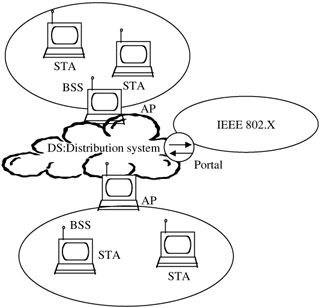6.2 Wireless LANs Clustering
6.2 Wireless LANs Clustering
The IEEE 802.11 Standard [2] used in numerous wireless LAN products has few roaming and clustering facilities. This standard maintains two basic modes of operation: (1) access point (AP) and (2) ad hoc. In the AP mode, users (mobile or stationary) group around a typically stationary station, which then resembles the base station of the cellular radio system. The AP may be connected to other APs by radio or other ground-based networks, but 802.11 does not address such interconnection. The access point is assigned a basic service set (BSS) identification (BSSID, or network ID), which distinguishes between neighboring APs, as shown in Figure 6.1. The amalgamation of BSS will constitute the extended service set. A mobile station roaming from one BSS to another will have to know the IDs of the BSS it is passing through. Most APs will come with a default BSSID; however, an operator can easily change this, therefore no two APs will share the same BSSID.

Figure 6.1: Infrastructure network.
When a mobile station is powered on, it tries first to see the availability of other APs to join. The AP is responsible for coordinating the sharing of the radio channel capacity among the nodes, authenticating the nodes, association with the nodes, and relaying various management and supervisory information to the nodes such as allowed transmission powers, etc. The AP determines when to switch the MAC access mode from contention mode (distribution function [3]) to the point coordination function where polling is used.
The mobile station goes through either active or passive scanning modes to check for such availability. In the passive scanning mode, it will listen to the pilot signal (called beacon) of the expected APs (BSSIDs are preknown) in the area, one after another. These beacon signals, typically transmitted every 100 milliseconds, carry the identification of the BSSID or the extended service set ID and synchronization, among other information. In the active scanning mode, the mobile station sends its own probing signal carrying a specific BSSID it wishes to join, and waits for a response from the corresponding AP. If a response is received from the AP in case of active scan or if the AP beacon is heard in the passive scan, the mobile station will proceed to the authentication and association phases. Details of these phases can be found in Gier. [4] If no response or beacon is heard, the mobile station will proceed to claim itself as the AP, typically after 10 seconds of scanning and trying to find other APs.
The standard allows mobile stations to roam among APs. As the associated signal gets weaker, the mobile station will reassociate (register) with another AP from which it has received a stronger signal (while still being associated with the original AP).
Lucent's Wave Around is a protocol that facilitates roaming among similar vendor APs. A beacon signal which contains the domain ID, the BSSID, quality of communication, and cell search threshold values is transmitted at a certain repetition rate from each AP. The mobile station listens to beacons to find other APs. This is triggered by continuous measurements of the current AP beacon power and comparison with the search threshold values. If the beacon frequency is low, this is considered a relaxed condition where responsiveness of the mobile station to lower received signal power is slow. If the beacon frequency is normal, then it defines a normal response. If the beacon frequency is fast, responsiveness is higher, meaning faster reaction of the mobile station to declining received signal power.
The cell search thresholds contained in the AP beacons determine the times at which a mobile station will switch to another AP or remain in cell search mode, depending on the quality of service (QoS) of the received signal at the mobile station. When this QoS is less than or equal to the "regular cell search" threshold, the mobile station will start to look for another AP, but it will switch to the new AP if the QoS of that AP is higher than the "stop cell search" threshold. "Fast cell search" threshold corresponds to the level of QoS at which the mobile station should immediately switch to any AP that yields better quality of service.
"Stop cell search" corresponds to the acceptable QoS range, meaning the mobile station will stop looking for a new AP. However, in this case three sensitivity levels arise: (1) "low" defines the condition where the mobile station should stay associated with the AP as long as possible, e.g., due to unavailability of other APs; (2) "normal" means that the mobile station will stay an average amount of time; and (3) "high" means that the mobile station will try to switch to another AP as soon as possible.
6.2.1 IAPP
The previous mechanisms of the standard work well for overlapping or nonoverlapping BSS as long as all APs are made by the same manufacturer. However, Lucent and other companies came up with the IAPP (Interaccess Point Protocol) to facilitate roaming between different vendor APs. IAPP uses UDP or IP on top of the 802.11 Protocol, and consists of the "announce" and "hand-over" protocols. The "announce" protocol informs APs about new APs, and all APs about networkwide configuration. The "hand-over" protocol informs one AP that one of its mobile stations has moved to another AP. In this case, the bending files will be transmitted to the new AP from the old AP. Filter tables (bridging functionality) are provided also by the hand-over protocol to enable the extended LAN configuration (similar to terrestrial LAN bridging).
[2]Gier, J., Wireless LANs Implementing Interoperable Networks, McMillan Technical Publishing, New York, 1999.
[3]Crow, P.C. et al., IEEE 802.11 wireless local area networks, IEEE Communication Magazine, September 1997, p. 116–126.
[4]Gier, J., Wireless LANs Implementing Interoperable Networks, McMillan Technical Publishing, New York, 1999.
EAN: 2147483647
Pages: 239